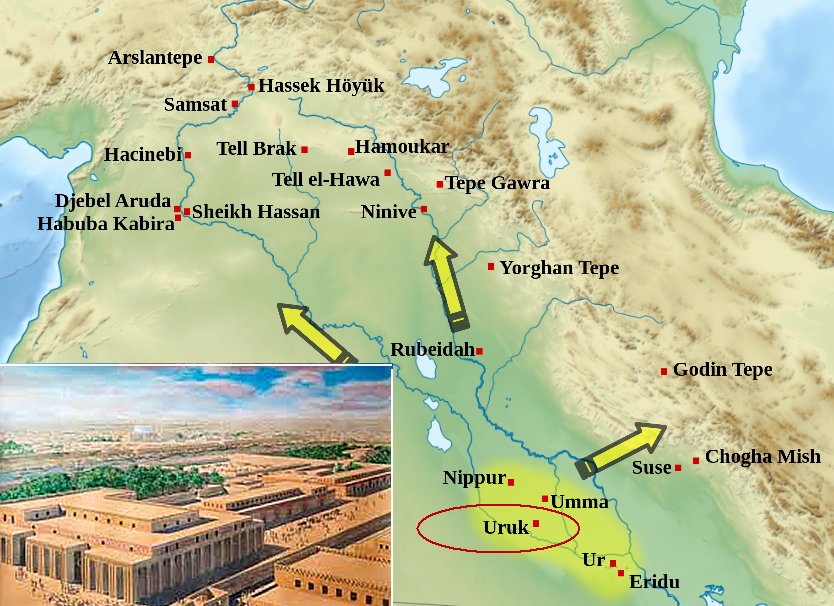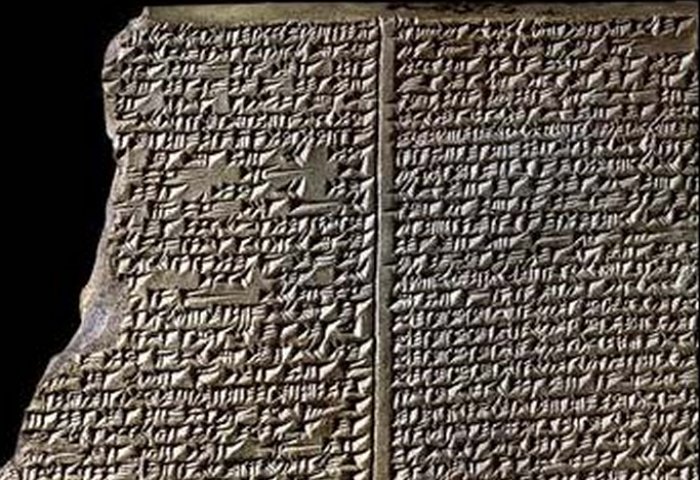Uruk Was Ruled By Gilgamesh Who Built City’s Great Walls
A. Sutherland - AncientPages.com - In Mesopotamian myths, Gilgamesh is presented as a demigod of superhuman strength that lived a very long life. Based on the’ Sumerian King List’, we learn that the great hero, Gilgamesh, reigned 126 years.
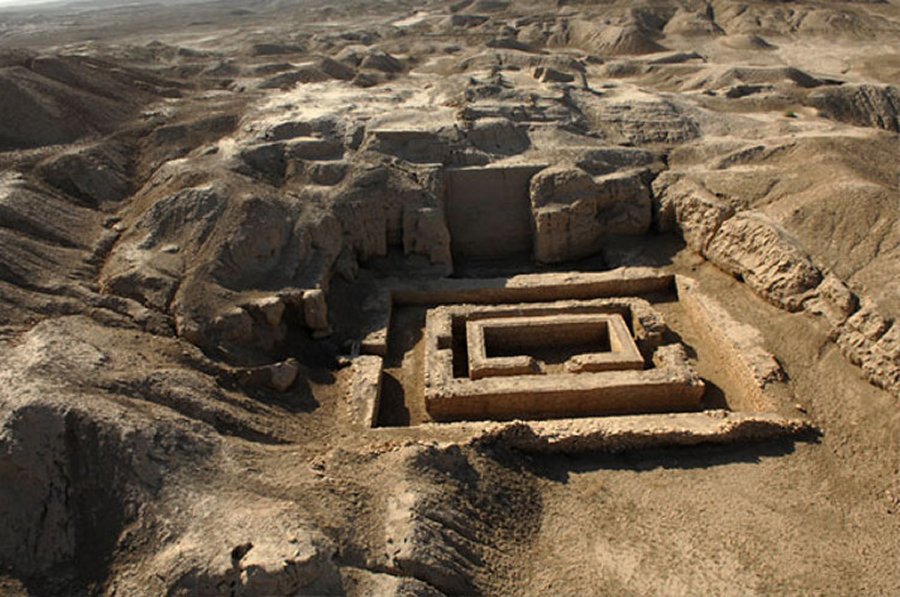
One of his greater achievements was the construction of the city walls of Uruk to defend his people from enemies.
He lived in the ancient Sumerian city of Uruk. He was the son of the mortal Lugulbanda and a minor goddess, Ninsun.
Gilgamesh built and beautifully remodeled this great city to honor An, the father of the gods, and his daughter, Inanna, the goddess of love and war. He also irrigated the fields, dug wells, and made orchards.
One of his greater achievements was the construction of the city walls of Uruk to defend his people from enemies.
The city of Uruk was an important Sumerian city:
'…The outer wall shines in the sun like the brightest copper; the inner wall is beyond the imagining of kings. Study the brickwork, study the fortification; climb the great ancient staircase to the terrace; study how it is made; from the terrace see the planted and fallow fields, the ponds and orchards. One league is the inner city, another league is orchards; still another the fields beyond; over there is the precinct of the temple.
Three leagues and the temple precinct of Ishtar measure Uruk, the city of Gilgamesh….'
According to the Sumerian King List, Uruk was founded by King Enmerkar around 4500 BC and was the largest settlement in southern Mesopotamia, if not the world.
During the Early Dynastic period (2900–2350 BC), Uruk dominated Mesopotamia.
Towards the end of the fourth millennium BC, at about the time that writing was being invented but before it is able to tell us much, Uruk had already spread over some 400 hectares, and became greater in size and population than Rome, about 3000 years later, or Athens, when the northern and southern walls of the Acropolis were reconstructed and major temples including the Parthenon, were rebuilt under the leadership of Pericles during the Golden Age of Athens (460-430 BC).
Uruk was surrounded by a massive wall, which according to tradition was built on the orders of King Gilgamesh, who ruled around 2700 BC.
In the Epic of Gilgamesh’ is written:
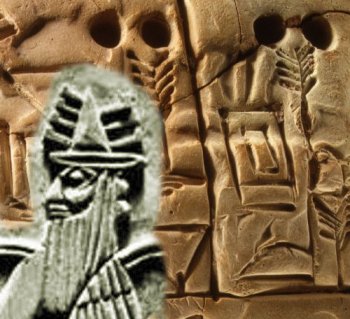 "….they arrived at Uruk, the strong-walled city. Gilgamesh spoke to him, to Urshanabi the ferryman, ‘Urshanabi, climb up onto the wall of Uruk, inspect its foundation terrace, and examine well the brickwork; see if it is not of burnt bricks; and did not the seven wise men lay these foundations?
"….they arrived at Uruk, the strong-walled city. Gilgamesh spoke to him, to Urshanabi the ferryman, ‘Urshanabi, climb up onto the wall of Uruk, inspect its foundation terrace, and examine well the brickwork; see if it is not of burnt bricks; and did not the seven wise men lay these foundations?
One-third of the whole is the city, one-third is the garden, and one-third is the field, with the precinct of the goddess Ishtar. These parts and the precinct are all Uruk.
This too was the work of Gilgamesh, the king, who knew the countries of the world. He was wise 'he saw mysteries and knew secret things, he brought us a tale of the days before the flood. He went a long journey, was weary, worn out with labor, and returning engraved on a stone the whole story…’
Uruk was a place of intense activity, a city of pulsating public life within its busy and impressive streets. The city had monumental mud-brick buildings decorated with mosaics of painted clay cones embedded in the walls, and richly decorated with art.
Large-scale sculpture in the round and relief carving appeared for the first time, together with metal casting using the lost-wax process.
Widely accepted as the historical 5th king of Uruk whose influence was so profound, Gilgamesh was later remembered in many stories and epics as a great hero.
Written by – A. Sutherland AncientPages.com Staff Writer
Copyright © AncientPages.com All rights reserved. This material may not be published, broadcast, rewritten or redistributed in whole or part without the express written permission of AncientPages.com
Expand for referencesReferences:
Kriwaczek, P. Babylon: Mesopotamia and the Birth of Civilization
Freeman, H. Sumerians: A History From Beginning to End
More From Ancient Pages
-
 Secrets Of Viking Crystal Sunstones Revealed By Modern Science
Archaeology | Apr 5, 2018
Secrets Of Viking Crystal Sunstones Revealed By Modern Science
Archaeology | Apr 5, 2018 -
 Magnificent New Trove Of Ancient Egyptian Artifacts And 250 Mummies At The Saqqara Necropolis
Archaeology | May 30, 2022
Magnificent New Trove Of Ancient Egyptian Artifacts And 250 Mummies At The Saqqara Necropolis
Archaeology | May 30, 2022 -
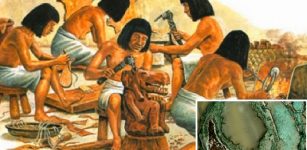 What Ancient Civilization Discovered Metallurgy?
Ancient Technology | Sep 19, 2017
What Ancient Civilization Discovered Metallurgy?
Ancient Technology | Sep 19, 2017 -
 Ancient Warming Event May Have Been Trigged By Changes In Earth’s Orbit
Archaeology | Dec 13, 2022
Ancient Warming Event May Have Been Trigged By Changes In Earth’s Orbit
Archaeology | Dec 13, 2022 -
 Evidence Of Cosmic Catastrophe 12,800 Years Ago – Earth Collided With Fragments Of A Comet
Archaeology | Feb 2, 2018
Evidence Of Cosmic Catastrophe 12,800 Years Ago – Earth Collided With Fragments Of A Comet
Archaeology | Feb 2, 2018 -
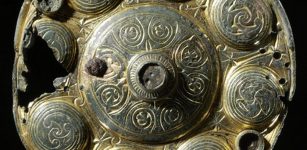 Viking’s Symbols Of Travels Prestige And Adventure Were Imported From Abroad
Ancient Symbols | Oct 1, 2015
Viking’s Symbols Of Travels Prestige And Adventure Were Imported From Abroad
Ancient Symbols | Oct 1, 2015 -
 The Writing Ball: A Great Invention In 1870
Ancient History Facts | Jun 30, 2016
The Writing Ball: A Great Invention In 1870
Ancient History Facts | Jun 30, 2016 -
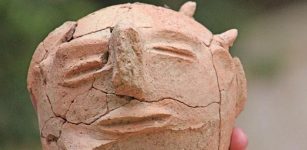 A Head Of A Statue Dated To 700 BC, Animal Figurines And Jordan Valley’s Occupation History
Archaeology | Sep 1, 2018
A Head Of A Statue Dated To 700 BC, Animal Figurines And Jordan Valley’s Occupation History
Archaeology | Sep 1, 2018 -
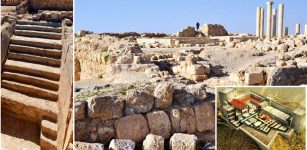 Ritual Bath In Herod’s Fortress Found In Ruins Of Machaerus, East Of Jordan River
Archaeology | Jun 16, 2017
Ritual Bath In Herod’s Fortress Found In Ruins Of Machaerus, East Of Jordan River
Archaeology | Jun 16, 2017 -
 Patara’s 2,400-Year-Old Ancient Kitchen And ‘Women’s Room’ Unearthed
Archaeology | Oct 7, 2020
Patara’s 2,400-Year-Old Ancient Kitchen And ‘Women’s Room’ Unearthed
Archaeology | Oct 7, 2020 -
 The Mixtec – Mysterious Very Advanced Culture Of The Foremost Goldsmiths Of Mesoamerica
Civilizations | Dec 2, 2017
The Mixtec – Mysterious Very Advanced Culture Of The Foremost Goldsmiths Of Mesoamerica
Civilizations | Dec 2, 2017 -
 Tiresias – Unusual Prophet Who Turned Into A Woman For Seven Years
Featured Stories | May 16, 2020
Tiresias – Unusual Prophet Who Turned Into A Woman For Seven Years
Featured Stories | May 16, 2020 -
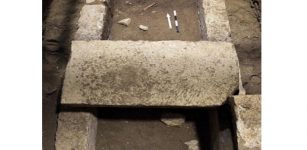 Mystery Greek tomb was dedicated to companion of Alexander – experts say
Civilizations | Oct 1, 2015
Mystery Greek tomb was dedicated to companion of Alexander – experts say
Civilizations | Oct 1, 2015 -
 Massive Menhir Champ Dolent Built By Fairies In Ancient Beliefs Of Brittany’s People
Featured Stories | Jan 13, 2025
Massive Menhir Champ Dolent Built By Fairies In Ancient Beliefs Of Brittany’s People
Featured Stories | Jan 13, 2025 -
 The Hidden Face Of The Elusive Master
Ancient Mysteries | Jun 8, 2018
The Hidden Face Of The Elusive Master
Ancient Mysteries | Jun 8, 2018 -
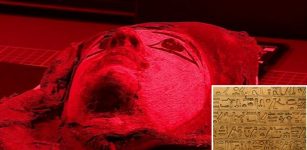 Secret Writing On Mummy Papyrus Revealed – Scan Technique Will Shed Light On Daily Life In Ancient Egypt
Archaeology | Jan 1, 2018
Secret Writing On Mummy Papyrus Revealed – Scan Technique Will Shed Light On Daily Life In Ancient Egypt
Archaeology | Jan 1, 2018 -
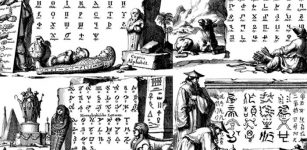 What Can Languages And Grammar Reveal About Our Ancient History?
Archaeology | Aug 20, 2021
What Can Languages And Grammar Reveal About Our Ancient History?
Archaeology | Aug 20, 2021 -
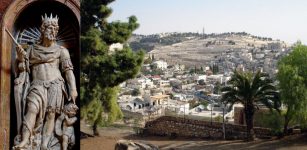 The City Of David – Why Is It So Controversial?
Biblical Mysteries | Jan 9, 2019
The City Of David – Why Is It So Controversial?
Biblical Mysteries | Jan 9, 2019 -
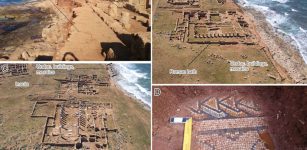 Archaeological Sites At Risk From Coastal Erosion On The Cyrenaican Coast Of Libya
Archaeology | Apr 15, 2023
Archaeological Sites At Risk From Coastal Erosion On The Cyrenaican Coast Of Libya
Archaeology | Apr 15, 2023 -
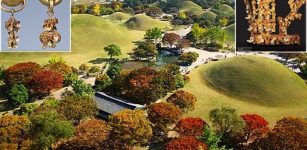 Silla: The Most Successful Of Three Korean Kingdoms
Featured Stories | Aug 22, 2023
Silla: The Most Successful Of Three Korean Kingdoms
Featured Stories | Aug 22, 2023

